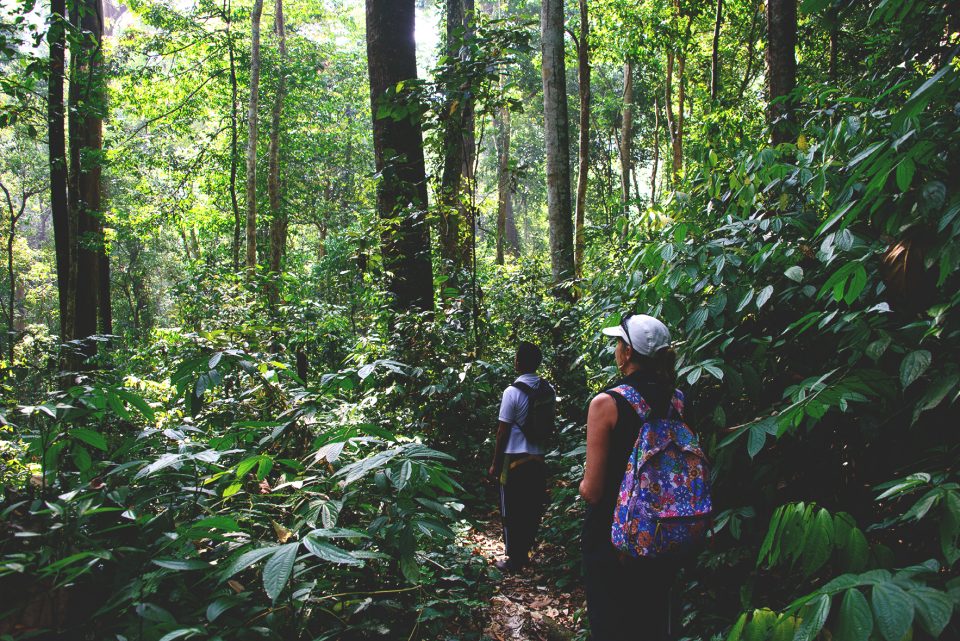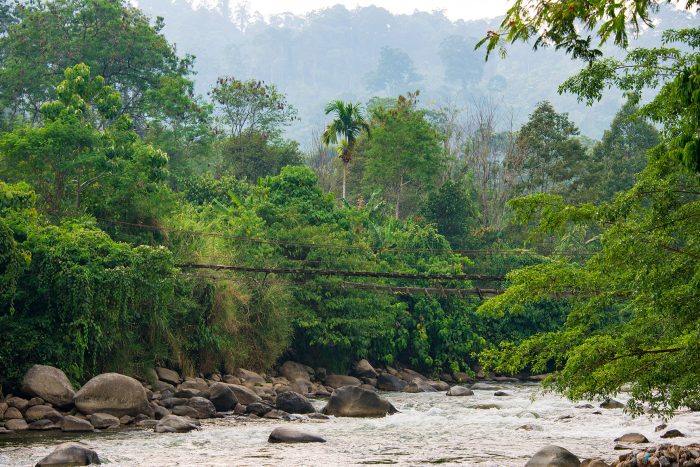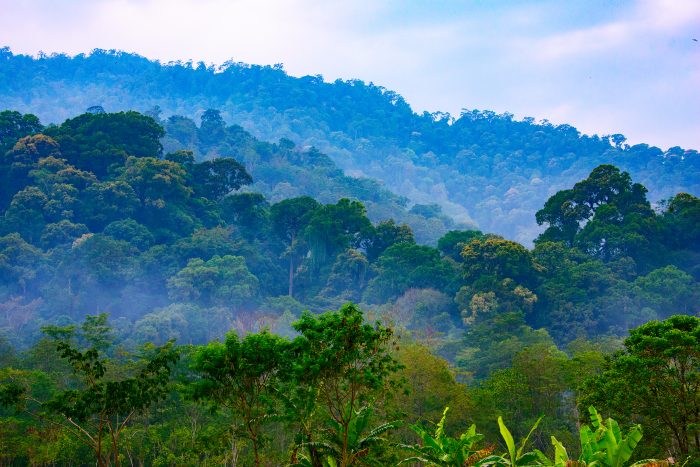You have to get up early to catch the wildlife, and by 5.30 am, the forest lodge was already a hive of activity. People were packing water and snacks, strapping on their camera equipment, lacing up their leg gaiters, and hurriedly heading out the door for their morning trek.
Gunung Leuser National Park, located in the Aceh and North Sumatra provinces, offers an extraordinary wilderness experience. The park is actually located on the border between the Aceh and North Sumatra provinces. Most people head to Bukit Lawang on the Sumatran side for trekking, as it’s well-established and attracts hundreds of tourists. Ketambe in Aceh is a more authentic wilderness escape. For some reason, Ketambe has remained under the tourist radar and let’s hope it stays that way.
Several trails start right from your forest lodge, and within five minutes, you are in dense forest. I followed my guide’s advice. We walked in silence, obeying the rules of trekking, “follow the leader,” and “when the guide stops, you stop.”
Next instruction – “Stand dead still, wait and listen”.
The guide followed a trail of fruit droppings, dispersed here and there on the forest floor. This meant a bit of bushwhacking, but I was up for that. Soon enough, the guide signalled for me to stop. He pointed up, and there it was – a huge orangutan sitting in the canopy of the rainforest, towering 30 metres above me. He pointed out not just one, but three orangutans.
It was a moment that took my breath away. I don’t know why; maybe it’s the gentleness of these big, hairy primates, or the haunting thought that our DNA is so similar to theirs. They have the capability of showing deep emotion on their faces and in their actions. For me, that’s a tangible sign of our similarity. Indeed, when you see your first orangutan in the wild, it’s a very powerful experience.
It takes a trained eye to spot orangutans. Unless they are on the move, they are masters of camouflage. They sit very high in the treetops where they make a new nest every night.
Within minutes of spotting the three orangutans, a family of gibbons came into view. Their high-pitched, lyrical calls were beautiful. It is actually a song that builds in pace and lasts for approximately 20 minutes. Next, my guide pointed to the east and there, gliding through a narrow gap in the trees, was a magnificent, lone hornbill cruising gracefully on a steamy jungle air-stream. The hornbill continued on its path as its wings brushed foliage on either side.
I headed back to the lodge for lunch and eagerly swapped stories with my fellow homestay travellers. I got chatting with a couple of Germans, who excitedly shared with me, “We saw seven orangutans this morning, and we are going back for more. Where on earth do you see this? We are from Europe, and it is not possible to see this exotic natural beauty. We love staying in a humble, basic, low-key jungle stay. That’s why we travel, right?” he said with a large smile, “To experience things that are so different to what we know”.
After lunch, I was up for some rafting and so clambered into the back of an old, weathered truck, along with a folded raft, a bunch of oars, a foot pump, and two guides. We headed off to explore more wildlife – this time, river wildlife.
Travelling down the river gave me a great insight into village life, which I was able to observe along the river’s edge. As our raft passed villages, people waved and cheered. The children scrambled and fell over each other to try to keep pace with the raft. They would then provide some entertainment by jumping off rocks, impersonating animal calls, and generally clowning about. Great river entertainment!
The trip combined a series of swift-paced rapids with lots of slow, relaxed stretches on a gentler river current. When the clear river slowed down to a meander, we tucked the oars inside the raft, soaked in the serenity and silence of the wide-open river and floated.
Towering trees provided shade. I was in heaven. Now and again, we spotted giant black beehives dangling from the high treetops – wild honey on tap if only you could reach it. My guide assured me that the locals know how to scale the trees to death-defying heights and gather the honey, which they do at around 3 am when the bees are sleeping, thereby reducing the risk of being stung.
I asked the guide about tigers, and he explained, “I have worked in the park for eight years and have only seen one tiger. We were on a seven-day trek, and I spotted the tiger at the riverbank. I was fortunate. He was magnificent. Additionally, the park is home to herds of wild elephants. If you go on a seven-day hike or longer, you might chance a sighting, but it is very rare. Mostly, we only come back with tales of tiger and elephant track sightings. Our guests love to photograph the footprints, and that is enough. To know you are in elephant, tiger, and orangutan country is somehow enough,” he mused, “and this is a wild place. There are no feeding platforms here. This is raw nature, on tap”.
The “big five” are in the park – elephants, tigers, orangutans, rhinoceros, clouded leopards, and the smaller-sized sun bear. Your chances of seeing orangutans are around 85-95%. Along with exotic wildlife and the world’s largest flower, the Rafflesia, there are over 10,000 plant species in the park.
It’s a nature-lover’s dream, and if you stay in Ketambe on the Aceh side of the park, you can have a very close encounter with nature and walk the forest trails with very few other tourists. By visiting, you also help support a fantastic, low-impact eco-tourism program and preserve one of the many unique and beautiful wild places in Indonesia.
By Road:
Medan, Sumatra to Ketambe, Aceh – 230 km (7-8 hour drive)
By Air:
Local airlines operate 2-3 times a week from Banda Aceh to Kutacane (Alas Leuser Airport). It is only 30 minutes by road to Ketambe. You can book through the app Traveloka or use a local travel agent.
Accommodation:
Friendship Guest House
Tel: +6285296883624 – Contact Pak Ahmed
Email: info@ketambe.com
Website: www.ketambe.com
Trekking tours:
www.jungletrekkingketambe.com
Pak Ahmed can organise trekking (1-7 days) and rafting
The Gunung Leuser National Park was established in 1980 and gained Tropical Rainforest World Heritage Listing in 2004.
Stephanie Brookes is a travel writer and blogger with tales from Indonesia and beyond.
www.travelwriter.ws
http://www.facebook.com/stephtravelwriter
www.instagram.com/stephtravelwriter
Author –“Indonesia’s Hidden Heritage; Cultural Journeys of Discovery”
Update Sept 2025





